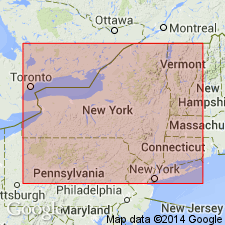
- Usage in publication:
-
- Geer Road bed
- Modifications:
-
- Revised
- Overview
- Dominant lithology:
-
- Mudstone
- AAPG geologic province:
-
- Appalachian basin
Summary:
Overlying the Kashong Member of the Moscow Formation is a newly recognized but yet unnamed member of the Moscow, which extends throughout central NY, from at least Hamilton in the Chenango Valley to just west of Bristol Valley where it is absent due to erosional truncation. Member contains four distinctive marker beds: Barnes Gully (at the base), MEGASTROPHIA beds, Curtice Road bed, and the Geer Road bed. The Geer Road bed is a shell rich mudstone separated from the Curtice Road bed below by a 3-m-thick shale interval referred to as LONGISPINA-MUCROSPIRIFER shales. The fauna of the Geer Road contains a diverse assortment of taxa and indicates the beginning of amarine flooding event. Above the shell interval is a 16-cm-thick faunal transition zone succeeded by the Little Beards Creek bed at the base of the Windom Shale Member. Age is Middle Devonian (Givetian).
Source: GNU records (USGS DDS-6; Reston GNULEX).
For more information, please contact Nancy Stamm, Geologic Names Committee Secretary.
Asterisk (*) indicates published by U.S. Geological Survey authors.
"No current usage" (†) implies that a name has been abandoned or has fallen into disuse. Former usage and, if known, replacement name given in parentheses ( ).
Slash (/) indicates name conflicts with nomenclatural guidelines (CSN, 1933; ACSN, 1961, 1970; NACSN, 1983, 2005, 2021). May be explained within brackets ([ ]).

